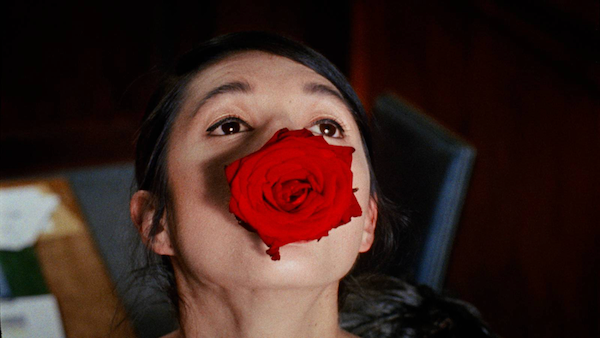Movie review by Greg Carlson
The combination of biographical information and artist statement found under the “about” tab at Ann Oren’s website partly reads, “By dissolving distinctions between plant, animal and human, she asks what it is to be human in an ecosystem immersed in digital culture. Questions about intimacy and identity keep emerging through various audio-visual approaches, while exploring gender, fictosexuality, animality, interspecies and other hybrid conditions.” Those sentiments surely represent truth in advertising concerning Oren’s feature directorial debut “Piaffe,” originally released in competition at the 2022 Locarno Film Festival and now popping up on a number of 2023 “best of” lists.
Beautifully shot on Super 16mm film by Carlos Vasquez, “Piaffe” follows the physical transformation and sexual awakening of Eva (Simone Bucio), a young woman who takes over the preparation of audio for a drug commercial when sibling and original Foley artist Zara ends up in the hospital following a nervous breakdown. The mercurial Zara, played by the nonbinary performer Simon(e) Jaikiriuma Paetau, significantly influences the trajectory of Eva’s experiences while remaining a mystery to the viewer. In 2020, Paetau appeared in Oren’s short “Passage,” which screened in multiple festivals and was recognized at Slamdance with a jury prize for Best Experimental Film.
“Piaffe” is an expansion of “Passage.” Both movies address metamorphosis through the supernatural growth of what becomes a luxurious horse’s tail on a human, but Oren uses the longer running time of “Piaffe” to dive more deeply into the ways that her protagonist is affected by radical change that manifests emotionally and intellectually as well as bodily. Any impulse to frame the somatic component of Eva’s mutation within the realm of Cronenbergian body horror is rapidly dispatched by Oren’s attitude, resulting in a kind of liberation that Sophie Monks Kaufman calls “body pleasure.” As the hair on Eva’s tail grows, so too does her sense of self and her way of being in the world.
The erotic influence of the horse is well-documented. In her 2008 thesis titled “Sex and Gender in the Equine in Literature,” Leah Graysmith describes an array of historical treatments, noting, “Perhaps the examples set in classical mythology and by Chaucer and Shakespeare have had an inspiring effect on later literature and cultural expression, or perhaps the continued proliferation of horses representing all things sexual is something intrinsic to culture.” Oren guides her viewers to identify with the taciturn Eva, using the experimentation of the Foley stage as a gateway to embrace the thrilling spark Eva feels once she engages some kinks in a dominant/submissive relationship with fern botanist Novak (Sebastian Rudolph).
Eva’s operation of the fotoplastikon where Novak examines stereoscopic images of plants is just one of Oren’s great visual designs. An antique kind of theater that rotates a set of fixed viewports into positions that pause long enough for the observer to briefly ponder illuminated cards, the fotoplastikon in “Piaffe” is simultaneously suggestive of a peep show, a horse training ring, and a cinematically-inclined zoopraxiscope (Oren has previously acknowledged the influence of “magician of cinema” Eadweard Muybridge). The curiosity inspired by the filmmaker’s sensuously presented fusion of flora and fauna will lead admirers to the special rewards discovered only through repeat viewings.
